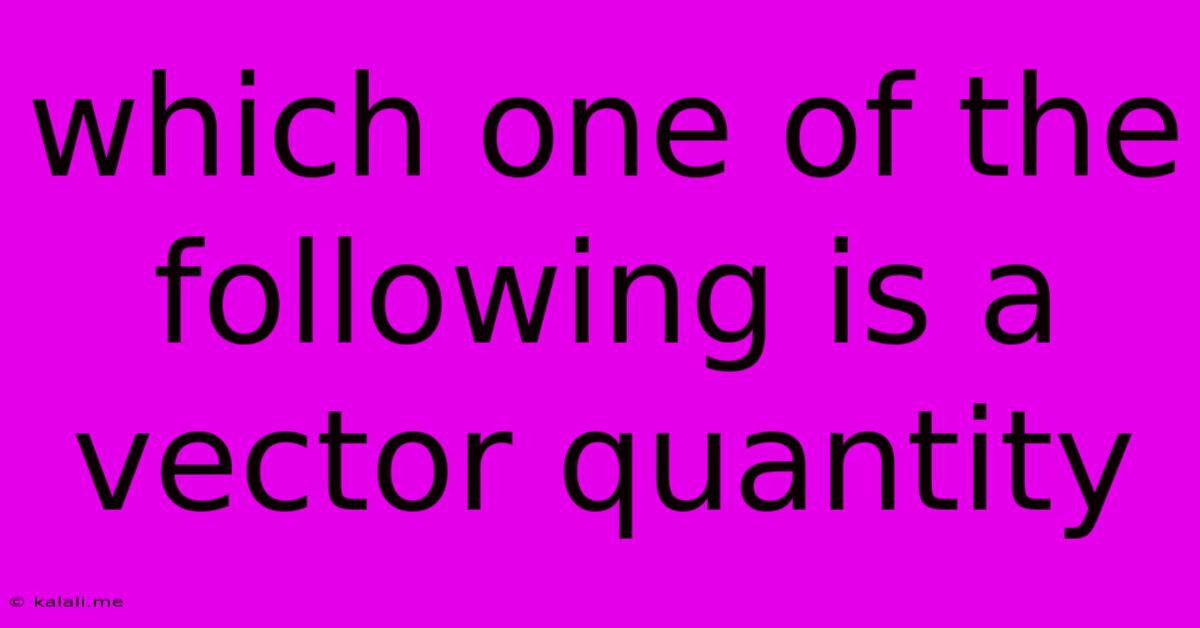Which One Of The Following Is A Vector Quantity
Kalali
Jun 14, 2025 · 2 min read

Table of Contents
Which One of the Following is a Vector Quantity? Understanding Vectors and Scalars
This article will explore the concept of vector quantities and differentiate them from scalar quantities. We'll clarify what defines a vector and provide examples to help you easily identify them. Understanding this distinction is crucial in various fields, including physics, engineering, and mathematics. This guide will equip you with the knowledge to confidently answer the question: which one of the following is a vector quantity?
What is a Vector Quantity?
A vector quantity is a physical quantity that has both magnitude (size) and direction. This means it's not enough to just know how much of something there is; you also need to know where it's going. Contrast this with a scalar quantity, which only has magnitude.
Key Differences: Vectors vs. Scalars
Here's a table summarizing the key differences:
| Feature | Vector Quantity | Scalar Quantity |
|---|---|---|
| Magnitude | Possesses magnitude | Possesses magnitude |
| Direction | Possesses direction | Lacks direction |
| Representation | Represented by an arrow (length = magnitude, arrowhead = direction) | Represented by a single number |
| Examples | Displacement, velocity, force, acceleration, momentum | Speed, distance, mass, temperature, time |
Examples to Illustrate the Difference
Let's look at some examples to solidify your understanding:
-
Speed vs. Velocity: Speed is a scalar (e.g., 60 mph). Velocity is a vector (e.g., 60 mph North). Both describe how fast something is moving, but velocity adds the crucial element of direction.
-
Distance vs. Displacement: Distance is a scalar (e.g., 10 miles traveled). Displacement is a vector (e.g., 10 miles East). Distance measures the total ground covered, while displacement measures the straight-line distance from the starting point to the ending point, including direction.
-
Force: Force is a vector. To fully describe a force, you need to specify its magnitude (e.g., 10 Newtons) and direction (e.g., upwards).
-
Acceleration: Similar to force, acceleration is a vector quantity. It describes the rate of change of velocity, including both magnitude and direction.
Identifying Vector Quantities: A Practical Approach
When presented with a list of quantities, ask yourself these questions:
- Can I assign a direction to it? If yes, it's likely a vector.
- Does the direction matter in the context of the problem? If the direction significantly alters the meaning or effect, it's a vector.
Conclusion
Understanding the difference between vector and scalar quantities is fundamental in many scientific and engineering disciplines. By focusing on the presence of both magnitude and direction, you can confidently identify vector quantities and solve problems accurately. Remember the key examples – velocity, displacement, force, and acceleration – to help you differentiate vectors from scalars. This knowledge will significantly enhance your understanding of physical phenomena and problem-solving capabilities.
Latest Posts
Latest Posts
-
Is H2po4 An Acid Or Base
Jun 15, 2025
-
The End Product Of Protein Digestion Is
Jun 15, 2025
-
The Speed Of A Printer Is Measured In
Jun 15, 2025
-
Whats The Prime Factorization Of 63
Jun 15, 2025
-
Which Statement About Green Plants Is True
Jun 15, 2025
Related Post
Thank you for visiting our website which covers about Which One Of The Following Is A Vector Quantity . We hope the information provided has been useful to you. Feel free to contact us if you have any questions or need further assistance. See you next time and don't miss to bookmark.